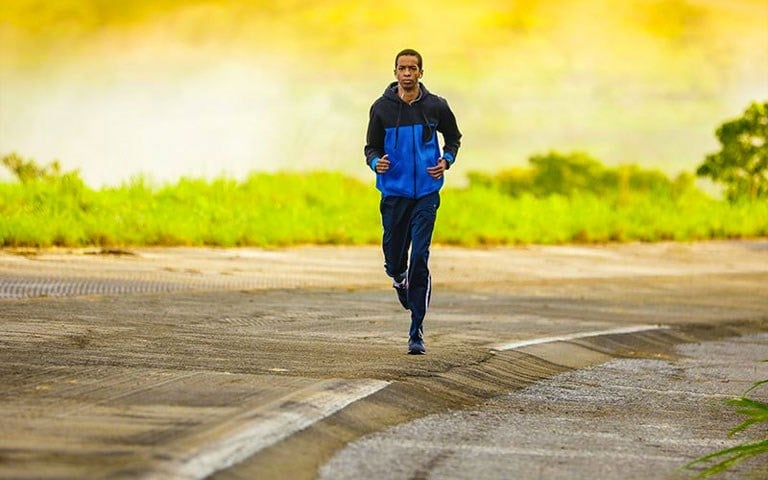My mother-in-law owns a machine that lays abandoned in her garage. We call it “The Jiggler.” It’s a vibration plate that she bought from an infomercial that promised it would help her burn calories and build muscle in a fraction of the time of conventional exercise. Sounds great! Who can blame her for answering the exhortation to “call now!”?
Vibration plates have recently made the leap from infomercials to social media, going viral on TikTok (and getting parodied on Saturday Night Live) with transformation videos showing people’s legs firming up and waistlines slimming down, supposedly from simply standing on a vibrating plate for 10 minutes per day—with links to buy the products (of course).
Experts In This Article
Do vibration plates actually work for strength training? The answer is more complicated than you might think. Studies show1 they can be an effective health and fitness tool for people who do not or might not exercise otherwise, such as older people or people with medical conditions. Vibration plate makers and training devotees often extrapolate those study findings to suggest vibration can impact anyone’s body in similar ways, positioning vibration training as a faster, easier alternative—or even a supercharged supplement—for exercise.
However, there isn’t definitive evidence that the success specific populations have had with vibration plate strength training translates beyond the scope of those studies to people more generally.
“In active healthy people and those who are already doing some strength training, the research doesn’t support that vibration plates can do much above what normal strength training can,” says exercise physiologist Sharon Gam, PhD, CSCS, ACE-HC.
In This Article
How can vibration plates build strength?
Lifting weights or pulling on resistance bands isn’t the only way to build muscle. Doing activities that challenge your balance, like standing on one leg, will also prompt your body to engage your muscles—including small stabilizer muscles—which can build strength when done repeatedly. Vibration plates make that balancing challenge supersonic, causing your muscles to get to work to attempt to stabilize you over and over again, for the duration that you’re standing on the vibrating plate.
“Having you in that unstable environment forces the body to react and get better faster,” says Davon Murray, an exercise scientist, trainer, and the director of fitness operations for Love.Life, a longevity-focused health, fitness, and wellness club.
This idea that your muscles have to constantly work harder to maintain balance is called “increased muscle fiber recruitment.”
“The theory is that the vibrations cause the muscles to reflexively contract, creating a similar stimulus in the muscles and nervous system to traditional resistance training, which can over time result in increased muscle function, strength, and muscle mass,” says Gam.
What is vibration plate strength training?
Given that theory, vibration plate strength training is intentionally using the tool as a way to build muscle. You can do this in a few ways.
First, you can stand on a vibration plate as a warmup before doing traditional strength training. This is theoretically similar to a dynamic warmup, as it could wake up your muscles, thus preparing them for resistance training.
“It makes sense that it might be helpful as a warmup prior to a traditional strength session [as] the muscle contraction in response to vibration would bring blood flow and prime the muscles and nervous system,” Gam says.
Alternatively, some people simply stand on a vibration plate for 10 to 20 minutes at a time. For people who are not usually active, this could provide enough of a challenge to the muscles to help them develop.
Finally, you can use the vibration plate in tandem with resistance training, by doing bodyweight moves like squats, burpees, and push-ups (or even weighted exercises) on the moving plates. You can even take classes that use the plates; PlateFit is a whole boutique fitness studio concept designed for vibration plate classes.
“If balance permits, we do jumping jacks, we do burpees, we do core,” says Murray, who leads vibration plate classes at Love.Life (the gym also has two vibration plates on the gym floor). “Anything you can do off the power plate, you can do on the power plate.”
Up to a point. Murray does not suggest lifting your maximum amount of weight on a power plate because the vibration makes the activity harder. You’ll theoretically need to expend your maximum effort with a lower weight; Murray suggests aiming for 50 to 60% of what you’d normally lift.
What the science says
How effective is adding some jiggle to your workout regimen? That likely depends on how active you already are. Think about it like any activity: If you’re someone who runs or does push-ups often, going for a short jog or doing 10 push-ups probably wouldn’t do much for you. But if you’re someone who does not get that activity regularly, it would help build strength.
That’s what the data says, too.
“Research supports the use of vibration plates for increasing strength and muscle in older adults (generally 65 and older), people with sarcopenia, which is an age-related loss of muscle mass and physical function, and for those with physical limitations that don’t allow them to do traditional strength training with weights,” Gam says. “Research also supports that it could be effective for people who were previously inactive and/or have a low baseline of strength and muscle.”
Multiple studies2 have investigated whether generally healthy adults can have greater strength gains by performing exercises on vibration plates. However, the results are inconsistent. For example, two studies looked at the effect of doing squats on vibration plates. One found that vibration yielded more gains3, and the other found no difference4.
“Even for beginners who might get some initial benefits, I think as their strength and muscle increases there would be diminishing returns,” Gam says. “That’s because once you build a reasonable amount of strength and muscle, you need to incorporate the principle of progressive overload to continue stimulating your nervous system and muscles to grow and get stronger.”
Basically, once your muscles master balancing on a vibration plate, continuing to add the plate won’t be enough of a challenge to stimulate more muscle growth. And you can only add more vibration, or heavier weights, up to a point before it becomes unsafe.
“If you’re doing advanced bodyweight exercises or using heavy weights, the vast majority of the stimulus would be coming from the exercises themselves,” Gam says. “The stimulus from the vibration would be relatively small at that point and I don’t think it would provide additional benefit.”
Murray would love to see additional research into vibration plates. However, he thinks the results and experiences of his pupils and clients speak for themselves, as does the fact that vibration plates are present in the training rooms and regimens of professional sports teams.
“I really think that we have just scraped the surface of what vibrational training can do,” Murray says.
He has found that doing any exercise on a vibration plate is objectively more difficult, and his clients value that they can get a challenging workout in under 30 minutes; Murray cites research5 showing that study participants exerted more energy and found a workout done on a vibration plate more challenging than one done without one.
Optimizing exercise: a double-edged sword
While vibration plate training has been around for decades, it has been popping up more on social media and in gyms and studios in recent years.
“There’s research on this subject going back about 30 years, but it does seem like recently it’s moved from specific niche populations like elderly people with sarcopenia or musculoskeletal conditions towards the general population,” Gam says.
Murray attributes this to that efficiency benefit his clients appreciate.
“We recognize a lot of people, they’ve got an hour at max, so it really gives you the ability to get in and get out, but your workout’s not suffering because of it,” Murray says.
If you approach your strength-training sessions with a bang for your buck mentality, you might miss out on some of the mental health benefits.
Trying to get the maximum benefit in the minimum time may have some drawbacks, though.
“A big benefit of strength training is how it can help you reframe your thoughts and ideas about yourself, giving you the opportunity to achieve small goals that help you see yourself as someone capable, strong, and resilient,” Gam says. If you approach your strength-training sessions with a bang for your buck mentality, you might miss out on some of the mental health benefits.
Ultimately, anything that can help people get active is a great tool to leverage. But a gadget can only do so much for building strength—the weight is mostly on you.
Well+Good articles reference scientific, reliable, recent, robust studies to back up the information we share. You can trust us along your wellness journey.
- Sañudo, Borja et al. “Whole-Body Vibration to Improve Physical Function Parameters in Nursing Home Residents Older Than 80 Years: A Systematic Review With Meta-Analysis.” Physical therapy vol. 104,5 (2024): pzae025. doi:10.1093/ptj/pzae025
- Osawa, Y et al. “The effects of whole-body vibration on muscle strength and power: a meta-analysis.” Journal of musculoskeletal & neuronal interactions vol. 13,3 (2013): 380-90.
- Marín, Pedro J et al. “A comparison of training intensity between whole-body vibration and conventional squat exercise.” Journal of electromyography and kinesiology : official journal of the International Society of Electrophysiological Kinesiology vol. 21,4 (2011): 616-21. doi:10.1016/j.jelekin.2010.12.008
- Hammer, Roger L et al. “Effects of Heavy Squat Training on a Vibration Platform on Maximal Strength and Jump Performance in Resistance-Trained Men.” Journal of strength and conditioning research vol. 32,7 (2018): 1809-1815. doi:10.1519/JSC.0000000000002565
- Milanese, Chiara et al. “Metabolic effect of bodyweight whole-body vibration in a 20-min exercise session: A crossover study using verified vibration stimulus.” PloS one vol. 13,1 e0192046. 31 Jan. 2018, doi:10.1371/journal.pone.0192046






